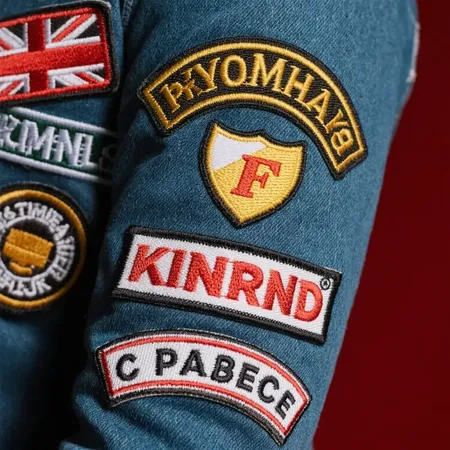When it comes to enhancing your wardrobe or workwear, patches for sleeves are both a fashionable and functional choice. From military uniforms to streetwear fashion, sleeve patches have become an iconic element in clothing design. Whether you’re looking to make a statement, repair damage, or represent your team or brand, there are endless creative and practical possibilities with sleeve patches.
In this comprehensive guide, we’ll cover everything you need to know about using, selecting, and customizing patches for sleeves, along with styling tips and application methods.

What Are Patches for Sleeves?
Sleeve patches are decorative or functional fabric or material pieces sewn or attached to the sleeves of jackets, shirts, hoodies, coats, or uniforms. These patches can display logos, names, rank insignias, artistic designs, or even fun slogans. They range from simple embroidered shapes to custom PVC, leather, or woven creations.
Unlike chest patches, sleeve patches are more visible from the side and offer additional space for personal expression or branding.
Why Use Patches on Sleeves?
1. Brand Representation
Many organizations, companies, and teams use patches for sleeves to reinforce their branding. For example, security staff uniforms often include company logos or unit insignia on the left or right sleeve.
2. Style & Personalization
Sleeve patches are a favorite among fashion brands, especially in punk, biker, military, and streetwear styles. Adding a bold graphic or text patch to a jacket sleeve instantly gives it character.
3. Repair & Reinforcement
A damaged or worn sleeve can be revived by adding a patch—not just on the elbow, but up and down the arm. Durable fabric patches can reinforce areas prone to tearing.
4. Commemoration & Identity
Military and emergency service personnel often wear patches for specific units, missions, ranks, or achievements on their sleeves. It’s a strong way to convey history and identity.

Types of Patches for Sleeves
Here are the most popular patch types used on sleeves:
● Embroidered Patches
These are classic, thread-stitched patches that are sewn or ironed onto clothing. They offer texture, color, and durability—perfect for both fashion and uniforms.
● Toppe in PVC
Ideal for outdoor or tactical use, toppe in PVC are weather-resistant, bold in color, and offer a 3D look. They’re often used on military or survival gear sleeves.
● Toppe tessute
With finer thread, toppe tessute allow for detailed designs, especially smaller text. They’re smooth, lightweight, and suitable for fashion garments.
● Leather Patches
For a more rugged, premium look, leather sleeve patches are a great choice. These are popular on varsity jackets and high-end apparel.
● Velcro Patches
Using hook-and-loop backing, Velcro patches can be removed or swapped easily. These are especially useful for uniforms that require different patch displays for different roles or events.

Placement Ideas for Sleeve Patches
The sleeve offers ample real estate for design and branding. Common placement options include:
- Upper arm (bicep area): Great for logo display or name patches
- Forearm area: Used for artistic or thematic designs
- Full-length sleeve designs: Often used in fashion to create a vertical graphic effect
- Elbow patches: Functional and stylish, typically used for reinforcement
Proper positioning ensures that the patch remains visible and doesn’t interfere with sleeve movement.
How to Attach Patches to Sleeves
The method of application depends on the type of patch and the garment material. Here are the most common options:
✅ Cucire
The most secure and traditional option, especially for heavy-duty wear or frequent washing. Sew-on patches for sleeves are ideal for leather, denim, or canvas garments.
✅ Stirabile
Quick and easy, perfect for cotton or polyester sleeves. Always check if your fabric can withstand heat, and be sure to press firmly for long-lasting adhesion.
✅ Velcro
Popular for uniforms or tactical gear where patches may need to be swapped. Be sure your sleeve has a Velcro base panel or sew one on first.
✅ Adhesive/Stick-On
Less permanent and ideal for temporary styling. These patches can peel over time and aren’t suitable for heavy washing.

Customizing Sleeve Patches
Want to create your own unique sleeve patch design? Here are a few tips:
- Start with the message or icon you want to display (name, logo, flag, etc.)
- Choose your patch material based on your use case—embroidered for classic texture, PVC for durability, or leather for sophistication
- Pick the right size and shape to fit your sleeve’s width and curve
- Decide on a backing—sew-on for permanence, Velcro for flexibility
Working with a professional patch maker can help turn your idea into a fully customized sleeve patch ready for branding, gifting, or retail.
Styling Tips with Patches for Sleeves
- Layered denim or bomber jackets look great with multiple patches on the sleeves
- Minimalist looks work well with a single patch on the upper arm
- Per edgy fashion, stack sleeve patches with different shapes and slogans
- Utilizzo themed patches (like music, clubs, anime, or causes) to express identity
Considerazioni finali
Whether you’re updating a jacket, reinforcing your uniform, or promoting a brand, patches for sleeves are a versatile and powerful tool. From subtle personal touches to bold branding, sleeve patches add character, function, and flair to your garments.
Explore the endless design options and get creative—your sleeves are waiting for their story to be stitched on.



